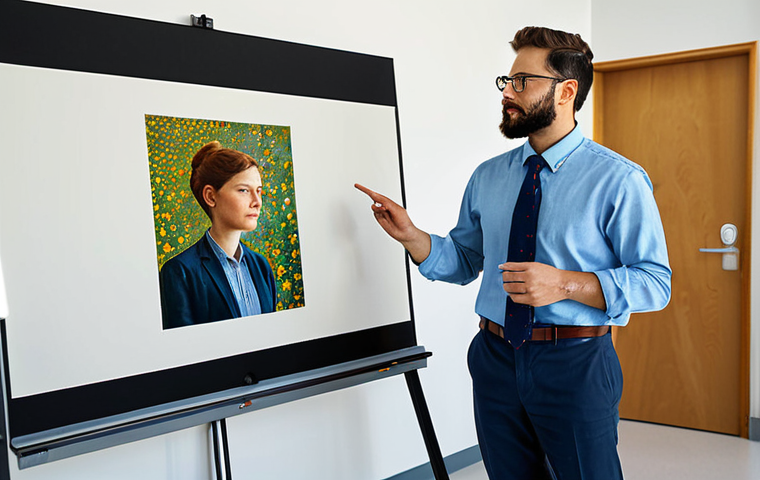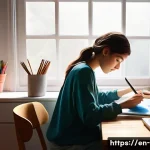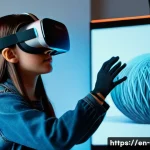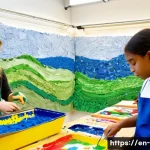So, you’re staring down the barrel of art school application season, huh? I remember that feeling – a mix of excitement and sheer panic! Figuring out what to include in your portfolio, making sure it reflects *you* and your style, and somehow standing out from the crowd… it’s a lot.
From my own experience of prepping my portfolio, trust me, a little planning goes a long way. The art world is forever shifting too. It’s no longer just about technical skill; they are looking for artists who are exploring the integration of AI in their practice.
What art schools want to see is evolving – are you keeping up with these changes? You’ve got to show you are ready for this brave new world. Let’s dive in and see what you need to do for that killer portfolio!
Let’s get the skinny on the perfect art school portfolio.
Alright, let’s get this art school portfolio nailed down.
Showcasing Your Artistic Voice: It’s More Than Just Pretty Pictures

Let’s be honest, technical skill is just the baseline. Everyone applying to art school can probably draw a decent still life. What schools *really* want to see is your unique artistic voice.
I remember one of my mentors telling me, “Your portfolio is a visual autobiography.” It’s about who you are, what you’re passionate about, and how you see the world.
Curation is King (or Queen!)
Don’t just throw everything you’ve ever created into a binder. Select pieces that tell a story, show a range of skills, and reflect a consistent artistic vision (even if that vision is still evolving).
Think quality over quantity. I’d rather see five amazing pieces than twenty mediocre ones.
Don’t Be Afraid to Experiment
Art school is a place to learn and grow, so don’t feel like you have to box yourself in. Include pieces that demonstrate your willingness to try new things, even if they’re not perfect.
Maybe you tried digital painting for the first time, or you experimented with a weird collage technique. Show them you’re not afraid to step outside your comfort zone.
I remember submitting this absolutely bonkers sculpture I made out of recycled bicycle parts. Did it get me into every school? Nope.
But it showed I was willing to take risks, and that resonated with some of the admissions committees.
Integrating AI: Showing You’re Ready for the Future
The art world isn’t just canvases and clay anymore. AI is shaking things up, and art schools know it. Show them you’re not living under a rock.
Exploring AI Tools in Your Process
Don’t be scared to show how you’ve been messing around with AI art generators. Maybe you’ve used Midjourney or DALL-E 2 as a starting point for a painting or sculpture.
Or maybe you’ve used AI to create textures for digital art. The key is to show how you’re using these tools creatively, not just mindlessly generating images.
Reflecting on the Ethical Implications
AI art raises some serious questions about copyright, authorship, and the very definition of art. Show that you’re thinking critically about these issues.
Maybe you include a piece that explores the relationship between humans and machines, or that comments on the impact of AI on creativity. It’s a sure-fire way to stand out from the crowd.
The Power of the Statement of Intent
The statement of intent is where you get to tell your story in your own words. Don’t treat it as an afterthought. This is your chance to explain your artistic vision, your goals, and why you want to attend that particular school.
Show, Don’t Just Tell
Instead of saying “I’m a creative person,” show them your creativity through vivid descriptions of your work, your process, and your inspirations. Use strong, active language.
Paint a picture with your words.
Tailor It to the School
Don’t use the same statement of intent for every school. Do your research. What are the school’s values?
What are their areas of expertise? How can you demonstrate that you’re a good fit for their program? For example, if you’re applying to a school known for its focus on social justice, you might want to highlight work that addresses social issues.
Presentation Matters: Make Your Portfolio Shine
A messy, disorganized portfolio screams “I don’t care.” Take the time to present your work in a professional and visually appealing way.
Photography is Key
If you’re submitting a digital portfolio, make sure your photographs are high-quality and well-lit. Crop out any distractions and make sure the focus is sharp.
If you’re submitting a physical portfolio, consider hiring a professional photographer to document your work.
Order Matters
Think about the flow of your portfolio. Start with a strong piece that grabs the viewer’s attention, and end with a piece that leaves a lasting impression.
Group similar works together, and create a visual narrative that tells a story about your artistic journey.
Crushing the Interview: Show Your Passion
If you get invited for an interview, congratulations! This is your chance to really shine and show the admissions committee who you are as an artist and as a person.
Be Prepared to Talk About Your Work
They’re going to ask you about your work, so be prepared to talk about it in detail. What were your inspirations? What were your challenges?
What did you learn from the process? Don’t just recite a memorized script. Be authentic and enthusiastic.
Ask Questions
The interview is a two-way street. Don’t be afraid to ask questions about the program, the faculty, and the school’s resources. It shows that you’re genuinely interested and that you’ve done your research.
The Nitty-Gritty Details: Tech Specs and Deadlines
Don’t let technical glitches or missed deadlines derail your application. Pay attention to the details.
Follow the Instructions
Each school has its own specific requirements for portfolio submissions. Read the instructions carefully and make sure you follow them to the letter. Don’t assume that what worked for one school will work for another.
Proofread Everything
Typos and grammatical errors make you look sloppy and unprofessional. Proofread your statement of intent, your resume, and any other written materials carefully.
Ask a friend or teacher to proofread them as well. Here’s a quick rundown of what admissions committees might be looking for:
| Element | Description | Why It Matters |
|---|---|---|
| Technical Skill | Demonstrated ability to use various art techniques and media. | Shows foundational competence. |
| Artistic Vision | Unique perspective, creativity, and ability to express ideas. | Sets you apart; shows individuality. |
| Conceptual Depth | Underlying meaning, themes, and ideas in your work. | Demonstrates critical thinking and intellectual engagement. |
| Experimentation | Willingness to try new techniques, materials, and approaches. | Shows openness to learning and growth. |
| Presentation | Quality of photographs, organization of portfolio, and overall visual appeal. | Reflects professionalism and attention to detail. |
| Statement of Intent | Clear, concise, and compelling statement of your artistic goals and why you want to attend the school. | Provides context for your work and demonstrates your commitment. |
| AI Integration | Thoughtful use of AI tools in your artistic process. | Shows forward-thinking and awareness of current trends. |
Preparing your art school portfolio is a marathon, not a sprint. Start early, be patient, and don’t be afraid to ask for help. And most importantly, let your personality shine through.
Good luck, you’ve got this!
Wrapping Up
Crafting an art school portfolio is a deeply personal journey. It’s about more than just showing your skills; it’s about revealing your passion, your perspective, and your potential. Embrace the process, be authentic, and let your unique artistic voice shine through. Good luck on this exciting adventure!
Handy Tips and Tricks
1. Attend Portfolio Reviews: Many art schools offer portfolio review days where you can get feedback from faculty and current students. This is invaluable for identifying areas for improvement.
2. Network with Artists: Connect with artists whose work you admire. Attend gallery openings, workshops, and lectures. Build relationships and get advice from people who have been where you are.
3. Visit Campus: If possible, visit the campuses of the schools you’re interested in. Get a feel for the environment, meet with faculty, and talk to current students. This will help you determine if the school is a good fit for you.
4. Stay Organized: Keep track of deadlines, requirements, and communication with each school. Use a spreadsheet or project management tool to stay on top of things.
5. Don’t Give Up: The application process can be challenging, but don’t get discouraged. Keep creating, keep improving, and keep believing in yourself. Your hard work will pay off.
Key Takeaways
Remember, your portfolio is a reflection of you. It’s your opportunity to show the admissions committee who you are as an artist and as a person. Focus on quality over quantity, be authentic, and let your passion shine through. Don’t be afraid to experiment, and don’t forget to proofread everything! Show them how you’re exploring the world of AI art, and don’t forget to present your work professionally. Believe in yourself, and good luck!
Frequently Asked Questions (FAQ) 📖
Q: How many pieces should I include in my art school portfolio?
A: Honestly, it’s not about quantity, it’s about quality. Most schools ask for around 15-20 pieces, but don’t feel pressured to reach that number if it means including subpar work.
Select your strongest, most diverse pieces that showcase your range and skills. Think of it like this: would you rather have 20 okay pieces or 15 pieces that absolutely blow people away?
I went with a smaller, stronger collection myself, and I think it definitely paid off. During portfolio reviews, the reviewers just kept going back to my core pieces and it really stuck with them.
Q: What kind of artwork should I include? Should it all be the same style or medium?
A: Variety is the spice of life, and it applies to your portfolio too! Showcasing different mediums and styles demonstrates your versatility and willingness to experiment.
Include drawings, paintings, sculptures, digital art – whatever you’re good at! However, make sure everything feels cohesive and reflects your artistic voice.
If you have a consistent theme or concept running through your work, even better! One thing I did was create a series of pieces exploring a particular social issue using photography and mixed media.
It showed I could think conceptually and execute it across different platforms, which I think they really appreciated.
Q: Should I include artwork I’ve created using
A: I tools in my portfolio? A3: This is the million-dollar question, isn’t it? The art world is still figuring out how to deal with AI.
I’d say, be transparent! If you’ve incorporated AI into your process, be upfront about it in your portfolio statement or descriptions. Explain how you used AI, what role it played in your creation, and what your contribution was.
Don’t try to pass off AI-generated art as entirely your own – that’s a recipe for disaster! Instead, highlight how you’re exploring AI as a tool to enhance your artistic vision.
Maybe you used AI for initial concept generation, or to create textures that you then painted over. Show them you’re not just clicking a button, but actively engaging with and shaping the technology.
Think of it like this: if you were a chef, would you hide the fact you were using a high-tech oven? No! You’d showcase how it helps you create something amazing!
📚 References
Wikipedia Encyclopedia






